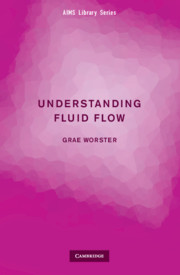5 - Interactions between linear flows
Published online by Cambridge University Press: 30 April 2024
Summary
Linear flow
In Chapter 6 we shall calculate some specific two-dimensional and three-dimensional inviscid fluid flows, but before doing so we’ll look a little more closely at some fundamental properties of general flows. We can represent the flow u(x) in the neighbourhood of a fixed point x0 with a Taylor series
Write u(x0) = u0 and x − x0 = r. Then to first order in |r| we have the linear flow
In suffix notation
where
are the symmetric and antisymmetric parts of the velocity gradient.
We have decomposed the general linear flow into three pieces: a uniform flow u = u0, a pure straining flow u = E · r and a pure rotation u = Ω · r, as described below and illustrated in Figure 23.
Pure straining flow
The strain-rate tensor E with components Eij given above is clearly symmetric. It is also traceless since Ekk = ∂uk/∂xk = ∇ · u = 0 from the continuity equation for incompressible flow. Because E is real and symmetric, it can be diagonalized: we can find principal axes with respect to which
with E1 + E2 + E3 = 0. An example of such a flowis the flowtowards a plane that we studied earlier, which had E1 = E, E2 = −E and E3 = 0 (see Exercise 12).
Exercise 18 Consider the pure straining flow given by E1 = E2 = −E, E3 = 2E. Find the velocity components (u, v,w) in cylindrical polar coordinates (r, θ, z). Determine the Stokes stream function for this flow and sketch the stream lines.
Vorticity
Recall the formula for the vector triple product
which can be written in suffix notation as
By analogy, we see that
Therefore we have
where
is called the vorticity of the flow. The flow u = ½ ω × r is a solid-body rotation with angular velocity ½ ω: the vorticity is equal to twice the local angular velocity of a fluid particle.
The vorticity equation
The Navier–Stokes momentum equation
can be written as
by again using the vector identity u × (∇ ×u) = ∇(½ |u|2) − u · ∇u.
Information
- Type
- Chapter
- Information
- Understanding Fluid Flow , pp. 63 - 70Publisher: Cambridge University PressPrint publication year: 2009
